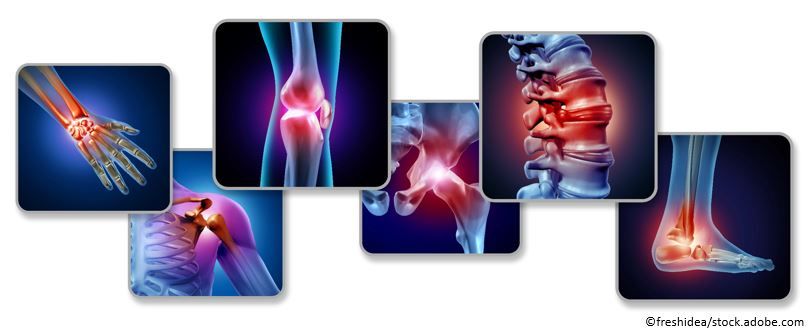- Clinical Technology
- Adult Immunization
- Hepatology
- Pediatric Immunization
- Screening
- Psychiatry
- Allergy
- Women's Health
- Cardiology
- Pediatrics
- Dermatology
- Endocrinology
- Pain Management
- Gastroenterology
- Infectious Disease
- Obesity Medicine
- Rheumatology
- Nephrology
- Neurology
- Pulmonology
Chronic Pain Affects 1 in 5 US Adults, Racial/Ethnic Minorities Most Vulnerable
An estimated 21% of US adults experienced chronic pain during 2021, and 7% reported high-impact pain chronic pain, according to new data from the Centers for Disease Control and Prevention (CDC). Chronic pain, defined as pain lasting ≥3 months, affected 51.6 million Americans in 2021 while 17.1 million were affected by high-impact chronic pain, ie, persistent pain that substantially restricts daily activities.
The prevalence of chronic pain in 2021, according to the findings published in MMWR on April 14, was similar to the 2016 estimate of 20.4%, reflecting a persistent burden on the lives of 1 in 5 Americans. One small bright spot in the report, however, was an observed decline in the prevalence of high impact chronic pain between 2016 (8%) and 2021 (6.9%).

The report is based on the CDC’s examination of data from the 2019-2021 National Health Interview Survey, a cross sectional poll conducted yearly by the National Center for Health Statistics. The goal for the analysis, conducted by S Michaela Rikard, PhD, of the CDC’s division of overdose prevention at the National Center for Injury Prevention and Control, and colleagues, was to update estimates of chronic pain prevalence in the overall US adult population and, importantly, within population subgroups defined demographic, geographic, socioeconomic, health status, and other characteristics.
FINDINGS
Consistent with past research, chronic and chronic high-impact pain were more prevalent in groups including older adults, women, veterans, and those with public health insurance. Findings from this analysis not reported before included a higher prevalence of both chronic and high-impact chronic pain among American Indian or Alaskan Native (AI/AN) adults, adults who identified as bisexual, and adults either separated or divorced from a significant other.
“Clinicians, practices, health systems, and payers should vigilantly attend to health inequities and ensure access to appropriate, affordable, diversified, coordinated, and effective pain management care for all persons,” wrote Rikard et al.
Subpopulation specifics
Race/ethnicity. Chronic pain prevalence ranged from 28.0% in AI/AN to 7.7% in Asian populations. High-impact pain was 12.8% in AI/AN respondents, but considerably less in white (6.5%) and Asian (2.1%) adults.
Gender. Among people identifying as bisexual, chronic pain prevalence was 32.9%, and was lower in people who identified as straight (19.3%) and gay or lesbian (20.7%).
Partners. Divorced or separated people had a higher prevalence of both chronic and high-impact chronic pain (29.6% and 10.1%, respectively) than married people (18.2% and 5.2%, respectively).
Socioeconomics. In an analysis of population groups defined by socioeconomic characteristics, the prevalence of high-impact chronic pain among adults with a family income <100% of the federal poverty level (FPL) (14.4%) was 4 times as high as those with family income ≥400 FPL (3.5%).
Disability. Adults reporting poor general health and adults with a disability experienced an exceptionally high prevalence of chronic pain (67.6% and 52.4%, respectively) and high-impact chronic pain (48.7% and 32.0%, respectively).
Conditions. After assessing all chronic medical conditions reported in the survey, the investigators found the prevalence of chronic pain and high-impact chronic pain was highest among people with a history of myalgic encephalomyelitis/ chronic fatigue syndrome (70.0% and 43.8%, respectively) or dementia (54.9% and 34.2%, respectively).

Disparities in treatment of chronic pain and access to appropriate and affordable care are not novel findings, wrote study authors, but far more needs to be done to understand the inequities and to identify opportunities to overcome them.
“CDC’s 2022 Clinical Practice Guideline for Prescribing Opioids for Pain provides recommendations to promote a multimodal and multidisciplinary approach to pain management and implementation strategies to reduce disparities in pain management care,” investigators wrote. “In addition, policies and programs that address primary injury prevention, improved access to affordable, culturally responsive health care, and more effective pain management therapies can mitigate the burden of chronic pain.”
They expressed hope that the new findings will help inform policymakers, clinicians, and other researchers as they continue develop strategies to bridge gaps in equitable pain management among US adults.
Reference: Rikard SM, Strahan AE, Schmit KM, Guy GP Jr. Chronic pain among adults: United States, 2019-2021. MMWR Morb Mortal Wkly Rep. 2023;72:379-385. Published online April 14, 2023. doi:10.15585/mmwr.mm7215a1
